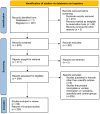A Systematic Review and Meta-Analysis Comparing the Diagnostic Accuracy Tests of COVID-19
- PMID: 37174941
- PMCID: PMC10177430
- DOI: 10.3390/diagnostics13091549
A Systematic Review and Meta-Analysis Comparing the Diagnostic Accuracy Tests of COVID-19
Abstract
In this paper, we present a systematic review and meta-analysis that aims to evaluate the reliability of coronavirus disease diagnostic tests in 2019 (COVID-19). This article seeks to describe the scientific discoveries made because of diagnostic tests conducted in recent years during the severe acute respiratory syndrome coronavirus 2 (SARS-CoV-2) pandemic. Between 2020 and 2021, searches for published papers on the COVID-19 diagnostic were made in the PubMed database. Ninety-nine scientific articles that satisfied the requirements were analyzed and included in the meta-analysis, and the specificity and sensitivity of the diagnostic accuracy were assessed. When compared to serological tests such as the enzyme-linked immunosorbent assay (ELISA), chemiluminescence immunoassay (CLIA), lateral flow immunoassay (LFIA), and chemiluminescent microparticle immunoassay (CMIA), molecular tests such as reverse transcription polymerase chain reaction (RT-PCR), reverse transcription loop-mediated isothermal amplification (RT-LAMP), and clustered regularly interspaced short palindromic repeats (CRISPR) performed better in terms of sensitivity and specificity. Additionally, the area under the curve restricted to the false-positive rates (AUCFPR) of 0.984 obtained by the antiviral neutralization bioassay (ANB) diagnostic test revealed significant potential for the identification of COVID-19. It has been established that the various diagnostic tests have been effectively adapted for the detection of SARS-CoV-2; nevertheless, their performance still must be enhanced to contain potential COVID-19 outbreaks, which will also help contain potential infectious agent outbreaks in the future.
Keywords: SARS-CoV-2; diagnostic tests; meta-analysis; sensitivity; specificity; systematic review.
Conflict of interest statement
The authors declare no conflict of interest.
Figures





















Similar articles
-
Serological testing for SARS-CoV-2 antibodies in clinical practice: A comparative diagnostic accuracy study.Allergy. 2022 Jul;77(7):2090-2103. doi: 10.1111/all.15206. Epub 2022 Jan 11. Allergy. 2022. PMID: 34986501 Free PMC article.
-
Recent advances in methods for the diagnosis of Corona Virus Disease 2019.J Clin Lab Anal. 2022 Jan;36(1):e24178. doi: 10.1002/jcla.24178. Epub 2021 Dec 17. J Clin Lab Anal. 2022. PMID: 34921443 Free PMC article. Review.
-
Sensitive and rapid on-site detection of SARS-CoV-2 using a gold nanoparticle-based high-throughput platform coupled with CRISPR/Cas12-assisted RT-LAMP.Sens Actuators B Chem. 2021 Oct 15;345:130411. doi: 10.1016/j.snb.2021.130411. Epub 2021 Jul 6. Sens Actuators B Chem. 2021. PMID: 34248284 Free PMC article.
-
Smartphone-Based SARS-CoV-2 and Variants Detection System using Colorimetric DNAzyme Reaction Triggered by Loop-Mediated Isothermal Amplification (LAMP) with Clustered Regularly Interspaced Short Palindromic Repeats (CRISPR).ACS Nano. 2022 Jul 26;16(7):11300-11314. doi: 10.1021/acsnano.2c04840. Epub 2022 Jun 23. ACS Nano. 2022. PMID: 35735410 Free PMC article.
-
[Recent advances in clustered regularly interspaced short palindromic repeats-based detection of severe acute respiratory syndrome coronavirus 2].Se Pu. 2022 Sep;40(9):773-781. doi: 10.3724/SP.J.1123.2022.08001. Se Pu. 2022. PMID: 36156623 Free PMC article. Review. Chinese.
Cited by
-
Evaluating Rabies Test Accuracy: A Systematic Review and Meta-Analysis of Human and Canine Diagnostic Methods.Diagnostics (Basel). 2025 Feb 8;15(4):412. doi: 10.3390/diagnostics15040412. Diagnostics (Basel). 2025. PMID: 40002563 Free PMC article. Review.
-
Pituitary Apoplexy in a Child with Short Stature and Possible Recent SARS-CoV-2 Infection.Diagnostics (Basel). 2025 Jun 7;15(12):1453. doi: 10.3390/diagnostics15121453. Diagnostics (Basel). 2025. PMID: 40564774 Free PMC article.
-
Biosensors and Bioassays for the Medical Detection of Bacillus Anthracis and Diagnosis of Anthrax.Curr Med Chem. 2025;32(16):3123-3133. doi: 10.2174/0109298673310620240704132204. Curr Med Chem. 2025. PMID: 39005126 Review.
-
Recombinant proteins as promising antigens applied to the immunodiagnosis of Chagas disease: a scoping review.Front Microbiol. 2024 Jul 30;15:1420226. doi: 10.3389/fmicb.2024.1420226. eCollection 2024. Front Microbiol. 2024. PMID: 39139374 Free PMC article.
-
Real-Time PCR Helicobacter pylori Test in Comparison With Culture and Histology for Helicobacter pylori Detection and Identification of Resistance to Clarithromycin: A Single-Center Real-Life Study.Helicobacter. 2025 Mar-Apr;30(2):e70031. doi: 10.1111/hel.70031. Helicobacter. 2025. PMID: 40193027 Free PMC article.
References
-
- World Health Organization WHO Coronavirus (COVID-19) Dashboard. [(accessed on 13 February 2023)]. Available online: https://covid19.who.int/
Publication types
LinkOut - more resources
Full Text Sources
Miscellaneous

